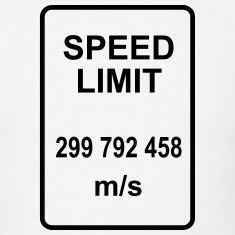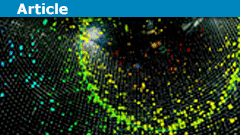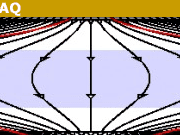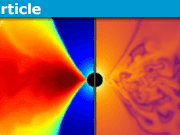Learn About Neutrino Masses and Speed
 It was hard to miss the 2011 OPERA neutrino speed measurement that indicated superluminal neutrino speeds (and turned out to be a measurement error), but measurements of neutrino masses and speeds have a long tradition.
It was hard to miss the 2011 OPERA neutrino speed measurement that indicated superluminal neutrino speeds (and turned out to be a measurement error), but measurements of neutrino masses and speeds have a long tradition.
Neutrinos are very light particles that interact via the weak interaction and gravity only. There are three types of neutrinos: electron neutrinos, muon neutrinos and tau neutrinos (and their corresponding antiparticles). Neutrinos are mainly produced in beta decays and some fusion reactions.
Their weak interaction makes it hard to detect them – they can travel through the whole Earth easily with a tiny probability of an interaction. Neutrino experiments need huge detectors (up to some cubic kilometers) to find them at a reasonable rate.
Table of Contents
Neutrino discovery
The electron neutrino was predicted in 1930 based on beta decays. Without the neutrino, it would be a two-particle decay, the electron would always be emitted with the same energy, and the remaining atom would always get a fixed (smaller) energy as well. Experiments clearly showed a continuous spectrum of the electron energy, so a third particle has to take the missing energy (and momentum) away.
Quantum mechanics allows to predict the electron energy spectrum depending on the (known) electron mass and the unknown neutrino mass. Observations quickly revealed that this new particle has to be very light compared to the electron – the experiments were just able to set upper limits. It had to be so extremely light that physicists expected it to be completely massless.
The electron neutrino was detected directly in 1956 (based on neutrinos from a nuclear reactor), without a better way to measure its mass. The muon and tau neutrino were discovered later, but the corresponding muon and tau decays are so high-energetic that it is hard to estimate the neutrino mass – only very high upper limits (~0.2 MeV, 18 MeV) are known from those decays. But why should we bother, if the particles are massless anyway?
Neutrino mixing
The Homestake experiment in the 1960s was designed to measure neutrinos from the sun. Neutrinos there could react with chlorine and produce radioactive argon plus an electron. The produced argon (about two atoms per day) was collected and the decays were measured. The observed rate was only 1/3 of the predicted rate. It was sufficient to confirm that nuclear fusion is the source of solar power, but as more experiments saw the same discrepancy something had to be wrong. This became known as the “solar neutrino problem”.
The chlorine to argon reaction is possible with electron neutrinos only. It was proposed that the different types can transform into each other. This “neutrino mixing” requires non-zero neutrino masses. The Sudbury Neutrino Observatory was the first experiment that could clearly detect muon and tau neutrinos coming from the sun.[1] It used heavy water, all neutrino types can split this into neutron plus proton, the neutron then gets captured and emits a high-energetic photon. The electron neutrino has the additional option to convert a neutron into a proton and an electron. That way, both the total neutrino flux and the flux of electron neutrinos could be measured. The experiment could confirm neutrino mixing. Later, mixing was also discovered in neutrinos from atmospheric muon decays and from neutrino beams from particle accelerators.
The mixing experiments show that neutrinos do have mass, but how large are they? Unfortunately, neutrino mixing does not allow to measure the masses directly. It mainly allows to find the absolute differences of the squared masses. One difference is about (75±2) meV2 and the other two are about (2450±50) meV2. The absolute differences mean the ordering of the masses is not known. There are two options – two lighter types and one heavier type (“normal ordering”) or one lighter type and two heavier types (“inverted ordering”). While the absolute masses could be anything, heavy neutrinos (a few hundred meV or more) would mean all three would have extremely similar masses in both cases. At least one type needs a mass of at least 50 meV.
Side remark: Mixing implies that the flavour eigenstates (“electron neutrino”, …) are not mass eigenstates (“m=123 eV”), so strictly speaking something like “the mass of an electron neutrino” does not exist. What experiments really measure is a superposition of mass eigenstates – I’ll ignore this detail here.
Current status
The current best direct upper limit on the electron neutrino mass comes from tritium beta decay: the mass has to below 2 eV.[2] Combined with mixing experiments, all three masses have to below 2 eV.
Another interesting way to measure neutrino masses comes from cosmology. In the early universe neutrinos were an important contribution to the energy density in the universe. The way they “cool” (and reduce their energy density) with expansion depends on the mass, it is different for relativistic particles and non-relativistic particles. This leaves traces in the cosmic microwave background. Planck and other experiments constrain the sum of the three neutrino masses, it has to be below 230 meV.[3] The precise value depends a bit on the model used.
At first glance, a measurement of the neutrino speed looks like a nice way to estimate neutrino masses: measure energy and speed, and relativity tells you the mass. Well… a 1 MeV neutrino from a nuclear reaction with a mass of 1 eV travels at roughly (1-10-12) times the speed of light. For a 1 GeV neutrino from an accelerator this gets even worse with (1-10-18). While light travels 1000 kilometers, the neutrino just gets behind by 1 nanometer or 1 femtometer respectively.
There is no way to see such a tiny difference, so measurements are expected to be consistent with the speed of light. Those measurement are still interesting: apart from light, the neutrinos should be the fastest things where we can measure the speed. It is a test of special relativity. In 2011 the OPERA collaboration announced that their measurements seem to indicate neutrinos that are faster than the speed of light by one part in 40,000.[4] They later discovered that a loose cable spoiled clock synchronisation at one point, and published updated results that are in agreement with the speed of light.[5] Due to the increased interest, multiple other experiments performed speed measurements, the most recent one (MINOS) this week[6]. All results agree with the speed of light, and a deviation has to be smaller than 1 part in 500,000.
This precision is remarkable – it requires to synchronize clocks with a precision of nanoseconds, and distance measurements as precise as a millimeter per kilometer. All the detectors are deep underground, where GPS does not work. In addition, how do you keep clocks synchronized if relativistic time dilation tells you the clocks at the accelerator site run faster than the clocks at your detector?
Again, astronomy gives a different approach. Experiments on Earth are limited by the size of Earth, sources in space give much longer baselines. Those sources are rare – supernova SN1987A is the only one where detected neutrinos could clearly be related to the supernova event. The neutrinos (24 detected in total) were detected about three hours before the visible light of the supernova reached Earth. No superluminal neutrinos here either, however – the supernova is not designed for our precision experiments. The neutrinos get emitted at the time the core collapses, it takes some time until the explosion reaches the surface. Supernova models allow to estimate this, and neutrino detectors can compare the arrival time of lower-energetic and higher-energetic neutrinos. This allows to constrain the neutrino speed to be close to the speed of light within 2 parts in a billion. It also translates to an upper limit of about 6 eV for neutrino masses.[7] The measurement is 28 years old, current detectors should be able to get much better results with a new supernova in a suitable distance.
Future experiments
The KATRIN experiment currently tries to push those limits down to 0.2 eV.[2] KATRIN does not study the whole spectrum. The electrons can have up to 18.6 keV kinetic energy, it is sufficient to study electrons above 18.5 keV only. A non-zero neutrino mass changes the shape at the very end of the spectrum slightly. There is no detector that can measure an electron energy of 18.6 keV as precise as 1 eV, so an electrostatic filter has to be installed that blocks all electrons below a specific energy. The measured rate of electrons passing the filter then gives the total fraction of electrons above the filter energy. Roughly one electron in five trillion is within the last eV of the spectrum, one in six hundred trillion within the last 0.2 eV (if the neutrino is lighter than that). To find those rare events, the decay rate has to very high and the background has to be understood very well. In addition, multiple effects limit the energy resolution – the tritium molecules can get some (variable) part of the energy for molecular excitations, electrons can scatter on their way to the detector, a completely homogeneous electric field for the filter is not possible and other issues.
While the 50 meV discussed above is only a lower limit, it is often expected that the heaviest neutrino is not much heavier than that. Several experiments try to reach this sensitivity. Cosmological constraints could get better and distinguish between normal and inverted ordering. More sensitive mixing experiments are another option: the main effect is independent of it, but smaller deviations depend on the ordering. When neutrinos travel through matter, they rarely make a hard interaction, but they are still surrounded by an electron field which alters their effective mass (in the same way electrons in metals behave different from free electrons). Therefore, mixing in matter is different from mixing in space, and the difference depends on the ordering.
Multiple experiments aim to determine the correct ordering within the next 5 to 10 years. Absolute mass measurements might follow.
Cosmology and beta decay lab experiments could come together in the future: PTOLEMY aims to directly detect the relic neutrino background from the big bang, and measure the energy of beta decays much more precisely than before.
An incomplete list of future neutrino experiments (planned or under construction):
DUNE
INO
JUNO
KATRIN
PROJECT8
More details on recent and past experiments:
1: SNO observation of neutrino oscillations
2: Upper limit on electron neutrino mass in beta decays
3: Limit on neutrino mass sum from PLANCK
4: Initial version of OPERA neutrino speed measurement
5: Revised version of OPERA neutrino speed measurement
6: MINOS speed measurement
7: Constraint on neutrino mass based on SN1987A
Working on a PhD for one of the LHC experiments. Particle physics is great, but I am interested in other parts of physics as well.









“Some of our Italian colleagues would probably also mention the omission of Cabibbo from the prize shared by Kobayashi and Maskawa (receiving 1/4 each with the other half to Nambu). That motivation was very carefully worded to explicitly target the extension of the mixing matrix to three states with the realisation that one CP phase no longer can be removed, leading to CP violation.”
Not easy wording indeed. Any reference to prediction of a third generation also should met with other italian claimant, Zichichi. And I always wondered if there were other claimants too for Cabibbo angle… surely not, but who knois… On other hand it seems -I had never looked at it- that Cabibbo’s idea immediately generated extensions to include CP, adding other phases and bigger groups, see eg Morales et al in 1965 [URL]http://cds.cern.ch/record/345977/files/CM-P00057116.pdf[/URL], and himself in 1964, [URL]http://www.sciencedirect.com/science/article/pii/0031916364911382[/URL] so it would seem that the real thing in KM is to have the right context in the quark model.
“I thought the prizes for the “hard sciences” can only be awarded to individuals (up to three people)?”Up to three organizations (or a mix) would be possible as well. It has never been done for the “hard sciences”, but it is possible.
Neutrino oscillations only show that two neutrinos have mass.
I thought the prizes for the “hard sciences” can only be awarded to individuals (up to three people)?
“This is also the problem with the big collaborations in experimental HEP.”It is possible to award the prize to organizations. It has never been done (apart from the Peace prize), but for experimental high-energy physics it would certainly be useful. There was a third spot for the Higgs discovery…
True! I found this also not very just. Here the dilemma is the restriction to maximally 3 people to get the prize. This is also the problem with the big collaborations in experimental HEP. Another omission is DESY for the discovery of gluons. There you also need good politics pushing single people out of the collaborations. CERN was doing better than DESY with Rubbia who got the prize for the discovery of the W- and Z-bosons (and van der Meer for stochastic cooling). I think the gluons are worth a Nobel prize as the W- and Z-bosons…
“The only example that comes to my mind is the omission of Lise Meitner and Strassmann in the prize for nuclear fission, given to Otto Hahn alone in 1945. Of course, the prize was well deserved but should have been shared with the key players in the discovery.”
Some of our Italian colleagues would probably also mention the omission of Cabibbo from the prize shared by Kobayashi and Maskawa (receiving 1/4 each with the other half to Nambu). That motivation was very carefully worded to explicitly target the extension of the mixing matrix to three states with the realisation that one CP phase no longer can be removed, leading to CP violation.
I think so, at least he should, because he was among the first (if not the first) having the idea of neutrino oscillations. To stress it again, I think the Nobel for SuperKamiokanda and SNO is long deserved (not to say overdue). I don’t understand, how ChrisVer can doubt this. It’s among the most exciting discoveries in HEP within about the last 20 years. Of course, there was the discovery of the ##tau## neutrino in 2000 and of the Higgs boson in 2012 (leading to the well-deserved Nobel for Higgs and Englert in 2013), but this was not that surprising, because it’s Standard Model Physics. The neutrino oscillations are really something new. The prize to Davis et al. was of course also well deserved and this indeed did not cover the discovery of the neutrino oscillations themselves, but I think that the understanding of where the solar-neutrino deficit came from was a prerequisite to give the prize to Davis et al in 2002, because before there was still some doubt about the validity of the measurements. With the SNO results, showing that with neutrino oscillations taken into account the solar-neutrino deficit was completely explained. It’s only a bit sad that Bahcall who worked on the solar-neutrino models for years and was found right after all this effort, couldn’t share the 2002 prize anymore.
I hate it, if Nobel prizes are somehow discredited, because one of the unique things with these prizes (at least the ones for the “hard sciences”) is that they are almost always very well deserved and justified. There are very little examples coming to my mind, where one can argue about that. The only example that comes to my mind is the omission of Lise Meitner and Strassmann in the prize for nuclear fission, given to Otto Hahn alone in 1945. Of course, the prize was well deserved but should have been shared with the key players in the discovery.
Sometimes you read stupid comments on why the one or the other prize was not deserved for the work honored, even in some serious newspapers. Some years ago the Frankfurter Allgemeine Zeitung (FAZ) in Germany wrote something against Abrikosov’s Nobel for the theory of superconductors (Abrikosov lattices), which argued that this is just “textbook physics”. At the time, I wrote a letter to the editor pointing out how stupid this is, because they should have thought, how this discoveries could come into the textbooks in the first place. It’s because of Abrikosov’s work, and thus it’s more an argument to justify to give him the prize than arguing against it!
“Would he share the prize if he was alive?”
I think that is a hypothetical question that only the Nobel committee could answer if anyone – and even if they knew the answer they would not tell anyone. The first step would have been to have someone nominating him, but I think that would be a minor hurdle.
“He was mentioned in the detailed presentation by the Royal Academy, but this is not something that media picks up on. It is not usually the case to mention other people in the short motivation which in this case was “for the discovery of neutrino oscillations, which shows that neutrinos have mass”.”
Would he share the prize if he was alive?
“I know that Bruno Pontecorvo is dead now and people can’t give him any prize, but why no mention of his name?”
He was mentioned in the detailed presentation by the Royal Academy, but this is not something that media picks up on. It is not usually the case to mention other people in the short motivation which in this case was “for the discovery of neutrino oscillations, which shows that neutrinos have mass”.
I know that Bruno Pontecorvo is dead now and people can’t give him any prize, but why no mention of his name?
“I think they didn’t know to whom to award the prize… afterall the solar neutrino problem was the most important indication for neutrino oscillations and the nobel prize was awarded because of that.”
The 2002 prize was awarded for the detection techniques used in neutrino astronomy, not for any oscillation measurement. The Super-Kamiokande atmospheric neutrino result is widely considered the first evidence for actual neutrino oscillations, the solar neutrino problem could have had other explanations. By measuring the total flux of neutrinos of any flavour and comparing with the electron neutrino flux, SNO was able to confirm that neutrinos do change flavour on the way from the Sun.
One curious thing to mention is that the solar neutrino flavour conversion mechanism is not really oscillations per se, at least not for the high energy boron-8 neutrinos, but rather resonant matter enhanced flavour conversion. Essentially all boron-8 neutrinos arriving at Earth do so in the second mass eigenstate.
Neutrino flavors (electron, muon and tau) are not mass eigenstates, but rather a mixture of mass eigenstates ν_1 , ν_2 & ν_3. As a result when you want to let the flavor neutrinos to propagate in time via the Hamiltonian (recall from QM that the state evolution with time is equal to the Hamiltonian operator acting on the state) you get for example:
$$nu_e(t)= e^{iHt} nu_e (0) $$
now since the Hamiltonian is giving the energy when acting on mass eigenstates you’re better to write the RHS of the equation in mass eigenstates and then you will obtain an exponential having the mass squared of the i-th eigenstate.
Finally as known from QM the probability of a transition from electron neutrino for example to muon is the square of the amplitude of those 2- that square brings in an additional mass squared of the j-th eigenstate and together with the first you get an o)cillation pattern for the probability governed by also the difference of the squared masses.
If they were zero (massless neutrinos), or I think degenerate (I’m not sure about this but I just put it to be checked) the oscillations would not occur and an electron neutrino would propagate as an electron neutrino forever. If there is any difference to the masses squared, oscillations occure and you have transitions.
So the fact that we saw missing electron neutrinos from the sun was telling us neutrinos are massive :p
I’m having trouble understanding why oscillations prove that neutrinos have mass. Why couldn’t a massless particle oscillate?
(I know nothing about particle physics, just heard about this prize today, and wanted to find out more.)
“This prize had already been given some years ago:”
That’s why personally I didn’t find the prize of this year any more interesting than the one (worthfully) awarded in 2002.
This prize had already been given some years ago:
[URL]http://www.nobelprize.org/nobel_prizes/physics/laureates/2002/[/URL]
I think this year’s prize is very well deserved. It’s among the most interesting discoveries in fundamental particle physics of the recent years (including the discovery of the Higgs in 2012 with Nobel prizes in 2013).
“Kajita and McDonald just won the Nobel prize in physics for their discovery of neutrino oscillations, which showed that neutrinos have mass. [URL]http://www.nobelprize.org/nobel_prizes/physics/laureates/2015/press.html[/URL]”
I think they didn’t know to whom to award the prize… afterall the solar neutrino problem was the most important indication for neutrino oscillations and the nobel prize was awarded because of that.
Kajita and McDonald just won the Nobel prize in physics for their discovery of neutrino oscillations, which showed that neutrinos have mass. [URL]http://www.nobelprize.org/nobel_prizes/physics/laureates/2015/press.html[/URL]
“Typo? Should that be “electron neutrino mass” ?”Oh sure. Fixed, thanks.
[quote=mfb]Current status
The current best direct upper limit on the electron mass comes from tritium beta decay: the mass has to below 2 eV.[URL=’https://www.physicsforums.com/insights/neutrino-masses-speed/#ref1′][2][/URL] Combined with mixing experiments, all three masses have to below 2 eV.
[/quote] Typo? Should that be “electron neutrino mass” ?
“[USER=510075]@Orodruin[/USER] With 3 anti-nu events, how can this be an exciting time?
Or is it going near the expectation for δcp=-π/2 and normal hierarchy?”
Well, first of all, T2K is getting antineutrino data. Getting both neutrino and antineutrino data is important in looking for CP violation (naturally). Second, the hint for maximal CP violation from T2K neutrino data is (assuming standard oscillations) an up-fluctuation regardless of where you are in parameter space. This is further accentuated by the fact that there is some tension with reactor data. Until the antineutrino run, essentially all there was was an up-fluctuation which was most likely in the case of maximal CP violation. Now there is a number of antineutrino events which are not statistically significant on their own, but suggestively twinkling their eyebrows at the previous best fit. We will know more over the coming years as T2K accumulates more data in the antineutrino run.
Also, more events would have been less exciting. It is the fact that there are hardly any events which is the signature trademark of ##delta_{CP} = -pi/2##.
[USER=510075]@Orodruin[/USER] With 3 anti-nu events, how can this be an exciting time?
Or is it going near the expectation for δcp=-π/2 and normal hierarchy?
Another update: OPERA now has 5 ##nu_tau## events, finally reaching the ##5sigma## level for the appearance of ##nu_tau##s in a ##nu_mu## beam. It does not do much in terms of determining the oscillation parameters, but it is an important consistency check.
Latest news in the neutrino sector: The first T2K anti-neutrino data was presented at the EPS-HEP conference this morning (see slides [URL=’https://indico.cern.ch/event/356420/session/10/contribution/322′]here[/URL]).
Summary: T2K observes 3 ##barnu_e## candidates. The expectation (including background) for ##delta_{CP} = -pi/2## and normal mass ordering is 3.7, with the expectation for any other combination of the neutrino parameters being larger. On its own, this is not yet enough to rule out the no-oscillation hypothesis in the anti-neutrino run, but the result is suggestively close to the expectation of the previous hint on ##delta_{CP}## from the combination of T2K neutrino results with reactor neutrino data. Exciting times!
Yes, great overview about neutrino masses, mixing, etc.
Ditto, great work @mfb!
The neutrino said "nice post!". The neutrino read the physics insight post.#causalityjokes